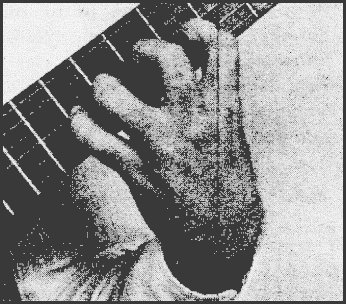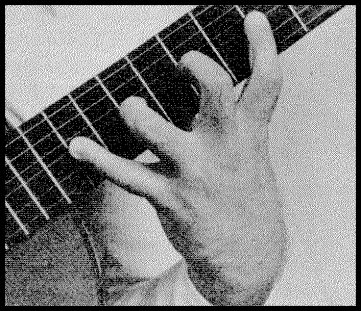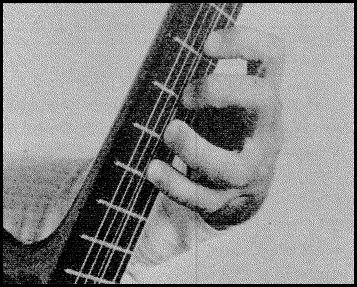
ANOTHER GUITAR WEB PAGE
by Tom Cipriani
This web page will be an on going column of sorts, primarily to inspire all guitarist, and to share information about the guitar.
I use to write a monthly column for "The Music Paper" for many years, and will be incorporating the info from many of those articles as a basis for this web page. New material will be included.
This web page will also be a reference for prospective students who want more info about my guitar methodology, background, and philosophy.
Guess a good place to start would be the history of music, and guitar.
There is a large amount of information regarding prehistoric, and historic music found on the web, and in books. Examples of debatable instruments include carved holes at specific resonance's in bones dating back about 35-45,000 years ago. Some flutes were found in China that date back to about 9,000 B.C.
A lyre dating back to about 2600-2300 BC, was found in the ancient region of Mesopotamia.
It is interesting to note, that historically music, and musical instruments were mainly applied in the sacred or spiritual realm.
History of music to be continued.....
Background:
Started taking lessons at 8 years old at a local music store with Mr. Piazza. Had a few bands, played the 7th, and 8th grade dances.--- Started classical guitar at 12 with Mr. Anthony Ruffolo.--- Studied Jazz, and Classical with Carl Mano at College. Carl Mano was a student of Rey de la Torre. ---At 20 started studies with Rey de la Torre, for about 2-3 years.---At 24 pushed some buttons to play solo classical at Carnegie Recital Hall, now know as Weill Recital Hall, to mixed reviews.---At 25 studied with Chuck Wayne for about 2 years, -Jazz-Theory-Plectrum-Composition, etc.---informal studies with Jimi Fiano, Harry Volpe, Gabe Amato, Dr. Lonnie Smith, and countless musicians I've worked with and have known---30 year span playing gigs when I can get them, from fine hotels to local pubs.
Methods of teaching:
Ok, those that can't play teach. I try to impart the concept of how important fundamentals are to guitar students. Some fundamentals being: tone, rhythm, phrasing, balance, logical fingering, logical theory, and technique. I try to make the student aware that they have the ability and responsibility to become their own teacher. This is achieved by seeing the benefits of using the fundamentals in a step by step manner. A few of these fundamentals are covered briefly below.
Rhythm:
All great musicians have an innate sense of rhythm. The music flows, it grooves, it weaves, its spiritual, it sounds musical. I think it's a gift from God, they may not necessarily know what it is, but they got it.
I've had to work on this my whole life, and still learning. But this is the essence. This is what I put my primary emphasis on when teaching. A three chord folk song, or a simple classical study that is played with a sense of rhythm sounds musical, without rhythm it doesn't.
In a rock, or jazz band, or in a rhythmic folk acoustic setting, it must be understood that the guitar is part of the rhythm section, and the same fundamentals that apply to the percussionist also apply to the guitarist.
Fundamentals of Rhythm to be continued....
Left Hand Technique:
The one asset of studying classical guitar that is most important for any guitarist is technique. This (more or less) standard technique is used by most stringed orchestral instruments to various degrees. It has probably evolved in one way or another through trial and error, and basic intelligence, and past down through the generations. I learned most of it from Rey de la Torre, and some, from a violin teacher in college.
The best way for one to introduce this method of guitar playing is to have an understanding of the phrase as Chuck Wayne would say "Economy of motion and Energy". That is to say, expending the least amount of energy to gain the maximum amount of efficiency. This concept is used by efficiency experts. The dictionary definition of "efficiency" is "the ratio of the effective or useful output to the total input in any system". This can be applied to any system be it manufacturing a widget, computer drafting, filing, running a construction crew, etc.
With this in mind , the first thing to learn is how to hold the guitar. The proper method is to angle the neck so that it is at about a 30-45 degree angle to the floor. Sit in such a way that the guitar supports itself without the use of the left hand. This leaves the left hand free, so no energy is wasted. Find your balance and center of gravity. In a future column I'll go into more detail on this.
The fingers of the left hand should be thought of as being equal in strength.

In the above photo (front view) the fingers seem to be arched. This is done to allow for optimum strength and stretch. Place the thumb in between the 2nd and 3rd fingers to form a counter balance. This way the pressure against the neck is distributed equally.
A stretch of 6 or 7 frets now become easier to attain.
See below.

The thumb should be basically counter to the fingers. Don't use the tip of the thumb. Make sure to use only enough pressure to obtain a clear tone. The fingernail joint should be perpendicular to the fretboard. Touching the string with the tip of the finger. A future column will go into more detail about the thumb.
The photo below illustrates the natural arch that the fingers should have.

Ok, so it should be known that it is typical for many guitarist, to stand or sit without proper balance, with the guitar neck basically horizontal, having the thumb over the neck, and not apply these principles. I play like that sometimes too. It's natural and correct for the thumb to be over the neck in a horizontal position, its just not optimum, especially with harder pieces that require significant stretches and difficult fingerings. I've seen and heard of many virtuoso guitar players that get into their forties and fifties with severe back, and hand problems. Or without knowing have altered their playing techniques to accommodate a less efficient method. Natural is a key word, because its unnatural for some players to use the left hand technique as described, so a compromise should be found. I'll go into more detail on this point in a another column.
These photos are just the tip of the iceberg as far as the left hand is concerned. These photos are to demonstrate how to play in the middle of the neck around the 5th-10th frets. When playing in the first position near the nut, it becomes much more difficult to practice these concepts, and more detail is needed regarding elbow position and pivots. 1st position will be covered in another column.
This might look difficult for a beginner, but it's actually the easiest, and fastest method of learning.
It is not uncommon to have a complete beginner playing full clear 1st position chords within weeks, not months. Full clear bar chords within months, not years. For Pros with 20 years experience it just takes some getting use to. I don't push the classical technique if the student doesn't want to learn it, even though its most likely the wrong decision.
Left Hand technique to be continued....
Fundamentals in general:
Many students want to learn their particular music (which is encouraged), and only take the fundamentals to a certain point. This situation then limits how much of their particular music they can learn.
Some students understand that the fundamentals (technique, rhythm , theory, etc.) are the answers to what is needed in order to play their type of music, so they mix both.
This is similar to the scenario in the movie the karate kid. The kid couldn't understand why he was just doing fundamentals to learn karate, when in the end, it turns out, the fundamentals were karate.
In other words, once you have a strong understanding of the fundamentals, you then have the all the tools, and know how to use them. Project Completed. You can then figure out the rest on your own.
Fundamentals to be continued....
Blues, Rock, Jazz, Improvisation, Solos:
Blues, Rock, Jazz, Improvisation, Solos, etc..... Brief explanation -- Ok, the answer is simple,...... but to get a good end result, it will require a lot of work. 1- learn: the fretboard inside and out, common sense theory, common sense fingering. 2 - learn how to sing the solos through the instrument. 3 - learn how to become your own teacher by figuring out any song off the CD, and working through and utilizing any book.
To be continued....
Teaching Experience
About 25 years of teaching guitar full, and part time, also experience as a High School Drafting teacher, and Jr. College computer drafter teacher. Many method classes relating to taking difficult subjects and breaking down the confusion to simplified logical fundamentals, presented in a step by step manor.
Brief list of recommended books:
Matteo Carcassi- 25 Melodious Studies Op. 60 Edited, fingered and explained by Rey de la Torre -- Editions Orphee
Guitar Studies -Scales- by Chuck Wayne...The School of Chuck Wayne --- Second Floor Music -- Hal Leonard Corporation
Guitar Studies - Chords- by Chuck Wayne...The School of Chuck Wayne --- Second Floor Music -- Hal Leonard Corporation
A Modern Method for Guitar - School of Tarrega -by Pascual Roch --- G. Schirmer
Twenty Studies for the Guitar by Fernando Sor -- Andres Segovia Edition-- Edward B. Marks Music Company --Hal Leonard Publishing Corporation
A Modern Method For the Guitar -- by William G. Leavitt --- Berklee Series Guitar
The Segovia Technique -- by Vladimir Bobri
Mickey Baker's Complete Course in Jazz Guitar -- Lewis Music Publishing Co.
The New Real Book --Sher
One of the most valuable tools for a musician is a tape machine. You can buy them at thrift stores for about 5 bucks. Reasonable quality tapes can be purchased at discount chain stores for about .50 cents. They are great for hearing what you are not doing, or doing correctly. With two tape machines you can play the chording and rhythmic patterns into one, then, play that back and record the melody or solo over it. If you have the money go multi-track digital.
Brief audio examples: mp3
1- Europa: by Santana -- Jam chord changes: Copyrights by respective owners
John Stultz - Drums / Rex Pierce - Bass / Bob Smith- Keyboard
________
2- Footprints: by Wayne Shorter -- Jam chord changes: Copyrights by respective owners
Eddie Fields - Drums / Big Willy- Bass
_______
3- The Grace of Saint Benedict: original © T. Cipriani 2006
_______
4- Norwegian Wood: by Lennon and McCartney: original guitar arrangement / Copyrights by respective owners.
© T.Cipriani 2006 except where otherwise copyright by others.
542 N. Summit Ave. Lake Helen Fl. 386-228-3737 / 386-785-7893
tcipriani@anotherguitarwebpage.com
References:
http://en.wikipedia.org/wiki/prehistoric_music
http://www.greenwych.ca/divje-b.htm
http://www.crystalinks.com/china2.html
The Music of Man by Yehudi Menuhin and Curtis w. Davis